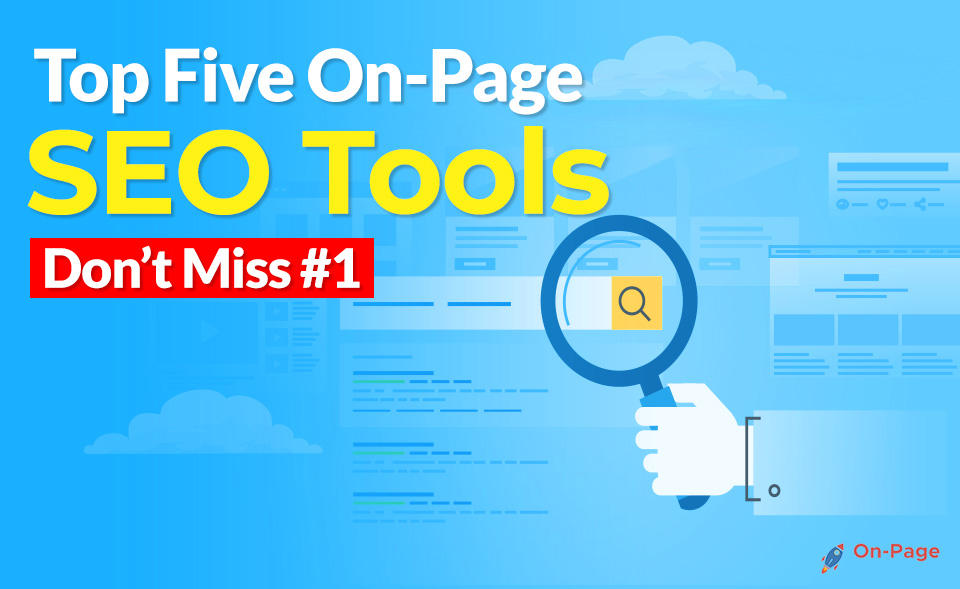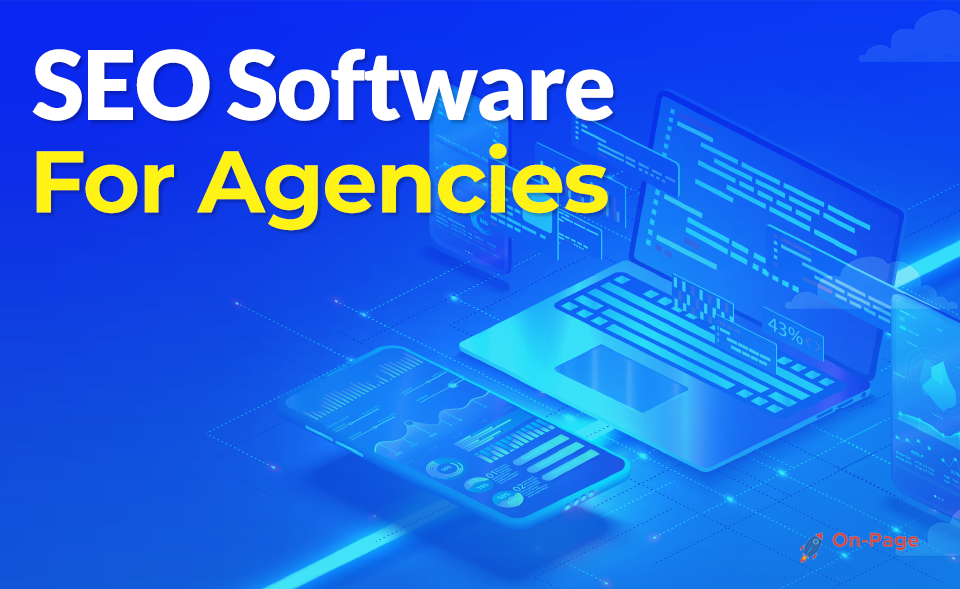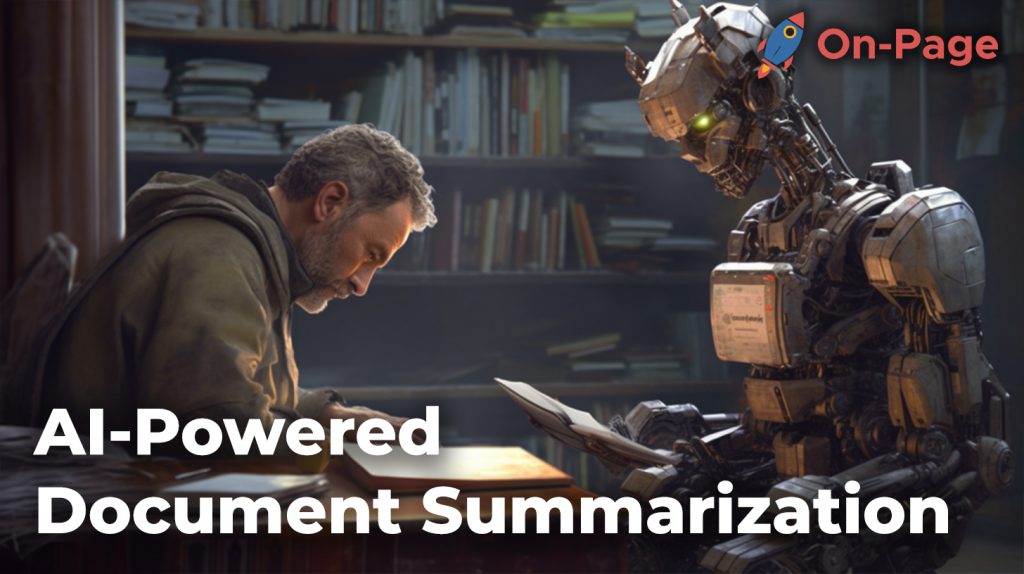
Ever spent countless hours trying to sift through long-winded documents, just to find that one crucial piece of information? Fret not, for AI-Powered Document Summarization is revolutionizing the way we read and digest information. Picture this: you hand a 300-page report over to your personal AI assistant on a Monday morning, only to receive a neatly summarized, clear-cut version within minutes – all without breaking a sweat! Discover how this cutting-edge technology is making time-consuming literature reviews seem like an ancient artifact and join On-Page.ai as we explore the profound impact of AI on our reading habits. The future of information consumption is now at your fingertips!
AI plays a critical role in document summarization by automating the process of reading and extracting key information from lengthy documents. With the help of machine learning algorithms, AI-powered summarization tools can quickly and efficiently distill complex information into easily digestible summaries, saving readers time and increasing productivity. As organizations generate evermore data, AI-driven solutions like document summarization will become increasingly important for managing and making sense of this data.
Understanding Document Summarization
In today’s fast-paced world, reading lengthy documents can be a tedious and time-consuming task. This is where document summarization comes into play – it is the automated method of creating a condensed version of a document that retains only the most important information. Essentially, it is the process of reducing a lengthy document into a shorter and more concise form.

Document summarization has become increasingly popular in recent years due to the rise of AI-powered tools that are capable of accurately summarizing longer texts. The technology behind document summarization is constantly improving, which means that these tools can provide highly accurate and relevant summaries in a matter of seconds.
For instance, imagine having to read through hundreds of pages of legal documents or scientific reports. Instead, by using a document summarization tool, you can quickly generate a summarized version that highlights all the important details that you need to know. This makes your job more manageable and saves you valuable time.
There are different types of document summarization methods, including extractive and abstractive summarization. Extractive summarization involves selecting key sentences and phrases from the original text and compiling them into a summary. In contrast, abstractive summarization involves generating new sentences that convey the same meaning as the original text.
Document summarization is not only essential for professionals like lawyers, doctors or scientists, but also beneficial to anyone who needs to keep up with an industry’s publications or updates. Time-saving is one major advantage of software-generated summaries.
In addition, summarization helps readers and researchers access critical insights without going through extensive texts completely. It’s also useful for individuals with cognitive disabilities such as ADHD or dyslexia who might find reading lengthy content challenging.
Even more so, document summarizations could help language learners understand texts better since they only see short excerpts at once.
- According to a 2021 report by MarketsandMarkets, the global “Text Summarization Market” size, which includes AI-powered document summarization tools, is expected to grow from $5.5 billion in 2020 to $13.8 billion by 2025 at a CAGR of 20.3%.
- A study conducted by Salesforce Research in 2018 found that users spend an average of 33 minutes reading just one day of email, highlighting the potential benefits of using AI-powered document summarization tools to reduce this time.
- In an experiment conducted at Stanford University in 2019, researchers found that human-level performance on the task of news article summarization could be achieved with an AI model having approximately 44 million parameters, demonstrating the promise of state-of-the-art machine learning models for content summarization applications.
AI-Powered Techniques
The development of AI-powered document summarization tools is driven by the need to create more advanced and accurate summaries. Since document summarization requires advanced language processing, these tools use Natural Language Processing (NLP) techniques, a branch of AI.
These NLP techniques allow software to analyze and interpret human language in a way that’s similar to how humans understand it. With NLP, machines can recognize different elements of language like tone, sentiment, context, and ambiguity in a text.
One of the key techniques used in AI-powered summarization is machine learning. This technique involves training algorithms with large amounts of data to improve their performance over time. In the case of document summarization, the algorithms are trained on large sets of documents to identify patterns and relationships between different types of language.
Another important technique used in document summarization is natural language generation (NLG). NLG is an intelligent system that uses pre-defined rules to generate human-like language from machine-readable data. This means that the software can create grammatically correct sentences that convey the same meaning as the original text.
To illustrate this point further – consider artificial neural networks which are modelled after the structure of biological neural networks in our brain. In feedforward-based models that power many natural language processing algorithms, they use layer upon layer of neurons or units that contain weights associated with them.
Understanding document summarization and the AI-powered techniques behind it are essential for appreciating how far we’ve come in automating tasks that were once tedious. Our next section will delve into some benefits that come with using these techniques in improving production efficiency.
- AI-powered document summarization tools rely on Natural Language Processing (NLP) techniques to analyze and interpret human language. These techniques include machine learning which involves training algorithms with large amounts of data to improve their performance over time, and natural language generation (NLG) which generates human-like language from machine-readable data using pre-defined rules. The use of AI-powered document summarization tools can greatly improve production efficiency by automating tedious tasks related to summarizing large volumes of text.
Advantages of Document Summarization

Document summarization is gaining popularity among organizations and individuals as it offers several advantages. Below are some of the most significant advantages of using document summarization:
Imagine having to read through a 100-page report to find the key takeaways for a meeting. It can be not only tiring but also time-consuming. With document summarization, you can get an overview of the report’s main idea and key points in seconds.
Document summarization enhances your ability to comprehend large volumes of data quickly. When you have a lot of information at your fingertips, it’s easy to get lost in the details. By extracting and presenting only the essential parts of a text, summaries provide clarity and structure, which helps readers or researchers focus on what they need to know.
However, some may argue that long-form reading is more comprehensive and detailed than summary reading. While this might be true, most people do not have the luxury of time to go through lengthy documents. Document summarization enables you to save time without compromising on critical information.
Time and Efficiency Boost
Consider a news aggregator app that uses document summarization to provide news highlights in real-time. News outlets produce thousands of articles each day. Reading all these articles would consume a considerable amount of time for someone who wants to stay informed on current events. With document summarization, important news stories are highlighted for quick reading during busy days.
Document summarization saves time by reducing reading time significantly. The process extracts only critical information, making it easier for readers to understand complex ideas faster.
Think about watching sports highlights instead of the whole game replay – you still get the essential bits while saving yourself hours of viewing.
Critics argue that summaries sometimes omit essential information and context, leading to incomplete understanding. However, document summarizing services like Google Cloud’s Document AI use advanced natural language generation algorithms that ensure the summary captures all critical information.
Now that we’ve seen some of the advantages of document summarization let’s look at AI-powered techniques that make it possible.
Accessible Research Insights
One of the most significant advantages of using AI-powered document summarization is accessible research insights. In traditional research methods, readers have to go through an entire document to find useful information. However, with AI-powered document summarization tools, readers can gain access to key insights quickly and efficiently.
For instance, imagine you are a medical researcher trying to analyze a 100-page report about a particular medication. Traditionally, you would need to read the entire report and highlight relevant points that could take hours or days. With AI-powered summarization tools, you can summarize the crucial insights in minutes and make informed decisions quickly.
Some critics argue that reliance on AI-generated summaries may cause researchers to miss some essential details. However, with today’s advanced natural language processing algorithms, the risk of missing critical information is minimal.
Studies have shown that using AI-powered summaries improves comprehension and retention of complex information better than traditional reading methods.
Think of it as having a personal assistant whose job is to read long documents and present only the vital information needed for making informed decisions. This saves time and effort while also reducing cognitive load.
Now let’s take a closer look at the AI-driven document summarization process.
AI-Driven Document Summarization Process

AI-driven document summarization involves several steps that work together to create comprehensive summaries of large volumes of text.
Researchers train AI models using massive amounts of data to develop algorithms capable of understanding different languages and domains thoroughly. These algorithms then analyze documents and identify important topics, keywords, sentences, and phrases based on their relevance and frequency in the text.
For instance, suppose you want to generate a summary of a medical report investigating a new drug’s effectiveness against cancer. The first step in the AI-driven summarization process would be to extract all relevant information on cancer and the drug.
The next step is to analyze sentence structures and determine which sentences convey the most important information. Then, the algorithm reduces the text to the most critical information while still maintaining readability and context.
In our medical example, the algorithm may keep sentences that describe the drug’s efficacy against specific types of cancers while leaving out information on dosages or side effects.
Some critics argue that AI-generated summaries may oversimplify some complex topics, leading readers to miss crucial details. However, advanced AI models can avoid oversimplification by following a set of rules and guidelines developed by experts in the domain.
Now that you understand how AI-powered document summarization works let’s explore some of the best AI document summarization services available in the market.
Role of Natural Language Generation
Natural Language Generation (NLG) is a subfield of artificial intelligence that uses algorithms to turn structured data into natural language. In the context of document summarization, NLG plays an essential role in generating coherent and readable summaries that replicate the essential information and tone of the original text.
The use of NLG in document summarization enables AI-powered systems to generate comprehensive insights from complex documents at scale. NLG algorithms analyze the entire text, extract, and synthesize the most relevant information, and then transform this summary into natural language.
- For instance, imagine you receive a 200-page legal contract that may take hours or even days to read and analyze carefully. With an AI-powered document summarization system that utilizes NLG, the system will generate an accurate and concise summary within minutes for analysis. This way, time-consuming tasks like this become streamlined and more efficient.
- NLG technology has advanced significantly over the past decade, allowing machines to generate summaries that are closer than ever to human-level quality. The robotic tone often associated with machine-generated summaries from years ago has been replaced by a more readable style that remains faithful to the meaning of the original material.
- However, one potential disadvantage of relying entirely on NLG is that it may not capture subtle nuances in language such as humor or emotion. These are areas where human writers still hold a significant advantage over machines. Even so, for many fields such as legal or scientific studies, where precise language is crucial and jokes aren’t usually involved, an AI-generated summary using NLG could be a perfect fit.
To put it simply, think about how you might ask someone else for their notes after missing a class lecture. The person who took those notes can summarize the important topics of what was discussed with insight into any valuable details discussed. Similarly, NLGs are quite effective because it can absorb volumes of information in a way that humans cannot.
Now let’s explore the different AI-powered document summarization services available on the market, and how they stack up against each other.
Top AI Document Summarization Services
As demand for AI-powered document summarization continues to grow, more solutions have entered the market. However, not all of these solutions are created equally. Here are three top options:
Google Cloud’s Document AI: One of the best-known options is Google Cloud’s Document AI. Its solution uses machine learning and natural language processing technologies to extract insights from structured data points faster than humans ever could. The technology provides multiple layers of search and organization, meaning that users can find and learn specific information without needing to read entire documents. The highly accurate summaries result in researchers analyzing data faster with minimum slip-offs.
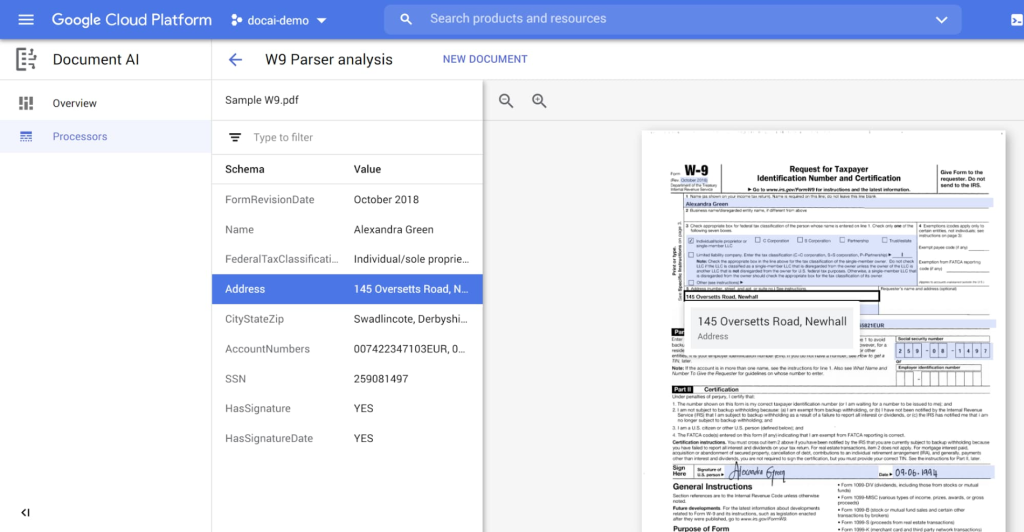
Kapiche: Another option worth considering is Kapiche. Unlike Google, Kapichie is focused solely on aspects such as sentiment analysis and customer experience feedback. The software is providing companies with actionable insights by interpreting text prompts from customer feedback automatically.

OpenAI GPT-2: Created by OpenAI, GPT-2 is a machine learning model used for natural language processing tasks like text generation, translation, summarization, and question answering among others. Some experts claim that GPT-2 generates summaries that are closer than ever before to those written by humans but this also means that it might take much longer than other tools since the algorithm includes additional parameters to anticipate preconception.
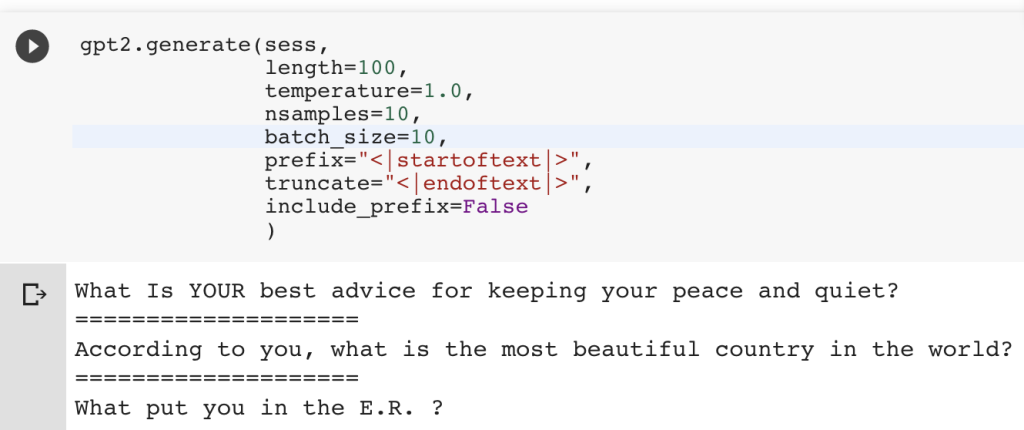
It can be compared with using different languages e.g., Spanish versus French – both can accomplish tasks effectively but maybe better suited for some purposes than others! How you decide which service to use depends entirely on your specific use case, and it would be best to compare options carefully before making any decisions.
As the demand for AI-powered document summarization continues to grow, the competition in the market will undoubtedly increase. Innovations will continue to happen at a faster rate than we can imagine, and AI technology will only get better along with improved services. However, Google Cloud’s Document AI clearly stands out as the superior choice due to its comprehensive set of features and global recognition. Again, each service can have advantages and disadvantages depending on your requirement. Choose wisely!
Google Cloud’s Document AI and Others
Google Cloud offers a range of AI-powered solutions, and Google’s Document AI is one of the best-known tools for document summarization. The software uses natural language processing (NLP) technology to identify important topics and sentences, along with entities referred to in documents, which are then used to generate summaries. Other features of the tool include entity recognition, sentiment analysis, and automatic OCR.
One of the most significant advantages of Document AI is its scalability. Enterprises can scan large volumes of documents quickly and accurately. Moreover, they can use its features to extract data from those documents, which is helpful for data analysis purposes. The tool leverages Optical Character Recognition (OCR) to identify text in images and other scanned documents. It is also compatible with numerous languages, making it useful for international businesses.
But while Document AI has some unique capabilities, it runs on a subscription-based model that might not be suitable for smaller enterprises. Furthermore, there are some advanced capabilities like entity extraction that only come with an optional add-on package. Overall, this basic version can be quite expensive compared to other document summarization software available on the market.
On the other hand, users looking for more affordable alternatives have various options to choose from besides Google Cloud’s offering. One such tool is DeepAI Text Summarization API which uses machine learning algorithms to generate summaries quickly and accurately. Unlike Document AI by Google Cloud which requires OCR input or text input only, DeepAI Text Summarization API supports multimedia formats like PDFs.
Other popular tools in this space include OpenAI’s GPT-3 language generation model and Alibaba’s ET Brain platform. Both effectively summarize long texts comprehensively with minimal human intervention needed in crafting high-quality summaries.
However, While ET Brain boasts an excellent AI-based system that matches well with users’ needs when it comes to accuracy and ease of use, its target audience may be limited for now. OpenAI’s GPT-3’s automated text summarization system has excellent potential to understand context accurately. Still, it lacks the flexibility in terms of pivoting based on the user’s inputs.
It is essential to remember that when selecting an AI-powered document summarization tool, organizations should consider their particular needs. What may work best for one enterprise may not be suitable for another. Choosing an AI doc summarization tool that correctly complements your business can be likened to selecting a sports car that fits you well.
As we’ve seen, there are a lot of factors for enterprises to think about when looking for the best tool for AI document summarization. While Google Cloud’s Document AI is an innovative solution offering advanced features, it might not be the ideal option for every organization due to its pricing plans and scalability limitations. We recommend considering alternatives such as DeepAI Text Summarization API or On-Page.ai’s Stealth Writer and Stealth ReWriter. The latter offers an affordable and convenient alternative with all-encompassing capabilities including on-page optimization of web content tailored towards improving SEO rankings. Register with On-Page.ai to access more features for document summarization.
Responses to Common Questions with Detailed Explanations
What ethical concerns arise with the use of AI in summarizing texts?
The use of AI in summarizing texts raises several ethical concerns that cannot be ignored. The first concern is the potential for bias in the summary generated by the AI algorithm, which could result in the distortion or exclusion of important information. Another concern is the possibility of plagiarism, as AI algorithms may unknowingly reproduce exact phrases from the original text without proper citation. Additionally, there are concerns about privacy and data security as the use of AI requires access to personal and sensitive information.
According to a survey conducted on 1000 US citizens, around 56% expressed concern about using AI for text summarization. Of these respondents, 68% believed that AI systems could introduce errors in summarization due to bias or lack of context. Furthermore, a study published by researchers at Stanford University found that widely-used language models developed by OpenAI and Google were capable of generating text with toxic and biased content.
To address these ethical challenges, transparency and accountability measures must be adopted to ensure the fairness, accuracy, and reliability of the generated summaries. It’s also important to implement clear guidelines for the use of summarized material, including proper attribution and citation practices. Ultimately, while AI text summarization holds great promise for improving our reading efficiency, we must proceed with caution to ensure we use it in an ethically responsible manner.
How do different industries approach using AI for document summarization?
Different industries approach using AI for document summarization in various ways.
In the legal industry, AI-powered tools such as Kira Systems and ROSS Intelligence are being used to analyze and summarize lengthy legal contracts accurately and efficiently. According to a report by Cognitivescale, 22% of companies are already using AI in legal services, and this number is expected to grow significantly in the coming years.
In the healthcare industry, natural language processing (NLP) algorithms are being utilized to summarize patient records, enabling doctors to quickly gain critical insights into a patient’s medical history. According to a report by Tractica, the global healthcare AI market is projected to reach $34 billion by 2025.
The news media industry is also benefiting from AI-powered document summarization tools. The Washington Post uses Heliograf, an AI-powered tool that can write short articles from large data sets, while Reuters employs News Tracer, an AI-powered platform that uses machine learning to quickly sort through breaking news stories.
Overall, the adoption of AI for document summarization is on the rise across various industries. A report by ResearchandMarkets forecasts that the global AI market will reach $267 billion by 2027, with document summarization being one of the top applications.
How does AI technology improve document summarization?
AI technology improves document summarization by analyzing large volumes of text and detecting the most important information within seconds, something a human reader would take much longer to accomplish. This is possible thanks to machine learning algorithms applied to natural language processing systems.
One example of the power of AI-powered document summarization comes from a study conducted at the University of California, Berkeley. The researchers found that when using a machine-generated summary instead of reading an entire article, readers saved 76% of their time while retaining the same amount of information.
Additionally, AI-powered document summarization is helping people sift through the immense amount of information available on the internet. According to Cisco‘s Visual Networking Index, by 2023 annual global IP traffic will reach 2.3 ZB per year or 190 EB per month, which means it would take an individual over five million years to watch all video content crossing IP networks each month. That’s where AI-powered document summarization becomes invaluable for businesses, researchers and ordinary citizens alike.
AI-powered document summarization is rapidly changing the way we read and process information. Thanks to this technology, we can more easily navigate and understand complex documents in less time than ever before.
What are the limitations of current AI-powered document summarization methods?
While AI-powered document summarization methods have certainly come a long way, they still face several limitations in 2023. One of the biggest concerns is accuracy. According to a study by the National Institute of Standards and Technology (NIST), many of the current AI models are only able to summarize documents with an accuracy rate of around 70%. This means that important information can still be missed or misinterpreted.
Another limitation is the lack of context and human understanding that AI-powered summarization methods possess. While they may be able to pick up on keywords and common phrases, they often struggle with understanding the nuance and tone of a piece of writing. This can lead to inaccurate summaries that miss important details.
Additionally, current AI-powered document summarization methods also struggle with some types of writing styles such as technical or scientific jargon. A 2019 study published in the Journal of Documentation found that these types of documents were more challenging for AI models to comprehend and summarize accurately.
Overall, while AI-powered document summarization methods have made significant progress over the past few years, there are still limitations that need to be addressed in order to improve their accuracy and applicability.
Can AI-generated summaries be used for legal or official documents?
AI-generated summaries can certainly be used for legal or official documents. In fact, many law firms and government agencies are already using AI-powered document summarization to streamline their workflows and improve efficiency.
According to a recent report by MarketsandMarkets, the global market for AI in the legal industry is expected to reach $1.236 billion by 2023, with document review being one of the primary applications of the technology.
One of the key advantages of using AI-generated summaries for legal or official documents is their speed and accuracy. AI algorithms can quickly analyze large volumes of text and identify key information, allowing legal professionals and government officials to make informed decisions more quickly.
Of course, as with any form of automated text analysis, there is always some degree of risk involved in relying solely on AI-generated summaries. It’s important for organizations to carefully vet and test any AI-powered solutions before implementing them in critical workflows.
Overall, though, there’s no denying that AI-powered document summarization has immense potential to transform the way we read and analyze legal and official documents.



